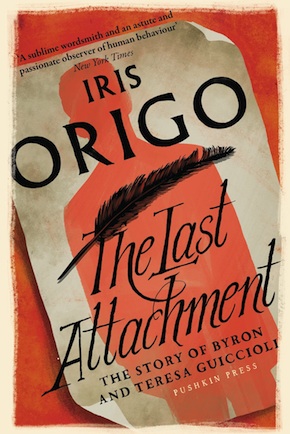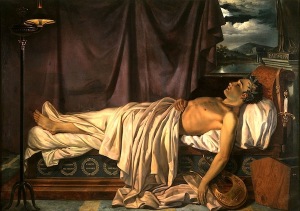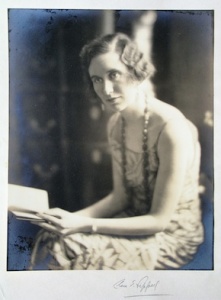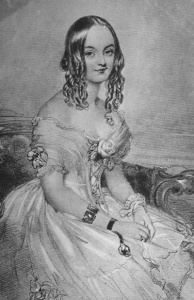The malediction of Minerva
by Mika Provata-Carlone
“As delicious as anything in Turgenev.” Times Literary Supplement
The story of the passionate last affair in Lord Byron’s life, a culminating point for many of his erratic, errant motion through truth and illusion, has always held a particular fascination for scholars; it has caused vocal perplexity to his admirers and deep-felt sighs of ‘if only’ to the many women (and men) who loved him desperately or were driven to despair by him. The sources have been many since the very start of Byron’s encounter with Countess Teresa Guiccioli – ranging from hearsay and more or less whitewashed confessions, to malicious gossip and painstakingly laboured, highly partisan academising treatises. Iris Origo’s own chronicle of “the story of two passionate, unstable human beings” has the virtues of rich eloquence, of drawing upon genuinely first-hand material until then untapped, unknown, cherishingly secreted away in “the Contessa Guiccioli chest” for a good hundred years. It has the unique power of providing a near-autobiographical voice to long-muted hearts and minds, and especially of conjuring up effortlessly, immaculately, the spirit of a place and the breath of an era.
Origo picks up the tone and style of 19th-century Italy and of that peculiar category that were the Englishmen abroad, Romantics and conservatives alike, creating a narrative where verisimilitude, historicity and her own meticulous, critical scholarly outlook walk hand in hand. Often she becomes the voice of those she follows as shadows, donning diction and sentiment with eerie precision and evocative poignancy. She shows us Byron’s smile, which Coleridge called “The Gate of Heaven”. “Madame Hoppner, that snake in the grass” she warns us, with a poised wink, against the obscure motivations, dubious sincerity and substantiality of meaning in the prized documents entrusted to her by Count Gamba – who had refused to share them until then with men of such renown as André Maurois. “Her fluent, persuasive, interminable letters exhale an aroma of Goldonian comedy, a heavy breath of patchouli” Origo writes of the reports that Fanny Silvestrini, Teresa Guiccioli’s companion, would write to both Byron and her mistress. The same, she cautions us, is true of Byron’s own letters and of Teresa’s, as well as of those of their entourage, where Goldonian comedy often became Machiavellian intrigue, and the waft of patchouli left a more acridly pungent, less agreeable trail.
It was Sir John Murray who stumbled upon the archives, after Maria Borghese had begun her own account of the attachment, which would have included letters in her possession. Borghese died before she could complete her work, and Iris Origo was invited to pick up the scent afresh. She was herself part of the English society abroad, echoing much of what Byron’s milieu would have been at the time; she was married to an Italian count, and so would have had that deeper insight and keener interest to decipher but also to understand. She had, especially, followed Byron’s steps before: in 1933 Origo had published with the Hogarth Press a short biography of Byron’s short-lived, illegitimate daughter Allegra, following fast upon the death of her own son Gianni. In the eyes of John Murray, Count Gamba, and perhaps in her own, Origo was the perfect listener, the finer filter, the clearest prism through which to search for the image behind another person’s shadows.
Byron himself nurtured, even if covertly, this elusive notoriety: ‘I am such a strange mélange of good and evil that it would be difficult to describe me.’”
Scandalous, flamboyant, the perfect narcissist, the ultimate tragic hero, swooningly attractive, a pioneering scholar in brief, dazzling outbursts, a martyr for the liberty of nations, a grand scoundrel and adventurer, the quintessence or the scourge of Englishness, an unsurpassed genius, or perhaps a very lonely, misunderstood, easily broken man, celebrated for his endless munificence and spontaneous generosity as well as for his darkly childish whims – these are all only some of the facets of the Byronic myth. Byron himself nurtured, even if covertly, this elusive notoriety of sorts: “I am such a strange mélange of good and evil that it would be difficult to describe me.”
The myth clashes ferociously with the man of flesh and blood, the mind and intellect where infinite curiosity joined hours of scholarly pursuit, the troubled thinker in whom freedom, equality, the dignity of the individual were as vital as breath, as staunchly upheld as the wildest escapade was pursued. There is, on the one hand, as Shelley tells us, the Lord Byron, whose “establishment consists, besides servants, of ten horses, eight enormous dogs, three monkeys, five cats, an eagle, a crow, and a falcon; and all these, except the horses, walk about the house, which every now and then resounds with their unarbitrated quarrels, as if they were the masters of it… I find that my enumeration of the animals in this Circean Palace was defective… I have just met on the grand staircase five peacocks, two guinea hens, and an Egyptian crane. I wonder who all these animals were before they were changed into these shapes.” And on the other, there was the fabulously wealthy patron, who never does anything halfway, the all-or-nothing incarnation of everything that Romanticism, in its virtues and excesses, was ever meant to stand for. The man who changed an era – almost singlehandedly, if Goethe and Victor Hugo are to be believed.
Origo’s angle is to present Byron warts and all through non-English eyes, and especially through the eyes of the protagonists themselves, yet from a very Anglo-Saxon perspective nonetheless, which is as unavoidable as it is engrossing and vital. “L’Anglico Mylord”, “so rich, so beautiful, so dissipated, so irascible” is revealed in Origo’s selection of letters and her critical analysis of the stages, emotions and lacunae of the relationship between him and the very young, very inexperienced, highly cultured and quintessentially Italian Countess Guiccioli, as a vain, inconsistent, but very vulnerable man, trapped within social and personal prescriptions, inhibitions, demands for conventions or bravura. We learn as much about Byron as we do about early 19th-century Italy and Europe, about the very unique character and idiosyncrasies of Venetian society, individual personalities and sociohistorical traits, about the world of art, its vital reality, as well as its fatality and falsehood. Also about contemporary politics and the retrospective assessment they receive in Origo’s eyes at a time of perhaps comparable turmoil, upheaval, doubt and questioning, underlying torrents. In both cases of past and present, Origo would herself find it difficult to separate judgement from self-conscious acquiescence: writing after a visit to Abyssinia in 1939, she would concede that “I am not defending the methods by which it was acquired. But the Arabs have kept their full rights, the Italians are creating farms where previously there had only been sand and scrub… Self-sacrifice and endurance, directed towards a constructive, powerful end” – adding about Mussolini’s agricultural policies in Sicily that “whatever his motive, and however imperfect, the execution is a good one.” Of Byron’s ideas about the freedom of nations, of the Carbonari, the Royalists and the Papal traditionalists, she will experience an equally fecund and telling vacillation. Her gift is to reveal both prejudice and adoration, vote of confidence and antiphon, for us to shift through – or be similarly troubled by.
This is a life of Byron – and of Teresa Guiccioli – with more than a touch of Henry James, with the darker, more melancholy hues and languor of Edith Wharton. It removes the veil of gentility from that travelling crowd of illuminati, aristocrats, enlightened bourgeois, from the stifling, explosively rattling mosaic of Italian mores and politics, exposing toxically obsessive friendships, masculine vice and ambition and female spite and frivolity, vanity and genius in equal measure, extremes and mediocrities. Origo expertly arranges her material, from the references to Tieck’s Bluebeard, Rob Roy, Dante and the Greek corpus or Benjamin Constant’s Adolphe and Madame de Staël’s Corrine ou l’Italie, so as to create a brilliant, almost dazzling anthology of perspectives, distortive mirrors, multiplying facets.
We learn that Byron visualised fleeing Italy and settling in Venezuela with Allegra; that in his view “the French courage proceeds from vanity, the German from phlegm, the Turkish from fanaticism and opium, the Spanish from pride, the English from coolness, the Dutch from obstinacy, the Russian from insensibility, but the Italian from anger, so you will see that they will spare nothing.” That “the edges of the pages on which [a letter] is written have unfortunately been nibbled by mice, so that none of the sentences are complete.”
This is a life of Byron – and of Teresa Guiccioli – with more than a touch of Henry James, with the darker, more melancholy hues and languor of Edith Wharton.”
Our sense, as shaped by Origo’s own account, is that a life of Byron, a vision of Byron as a whole man, cannot be complete either. Mice or men have nibbled at the edges, manuscripts have been burned (his own account of political events in Italy and his involvement in them was burned by Cavalier Angelo Mengaldo), and his personal life, his inner world and traumas, passions or eccentricities seem to emerge disconnected from his writing, his studies, his intellectual attachments, his politics, and his world of ideals and ideas. Outraged by Elgin’s hoarding of “maimed antiques”, Byron wrote a scathing satire and denunciation of what he saw as the “ravages of barbarous and antiquarian despoilers.” ‘The Malediction of Minerva’ (‘Malediction’ later changed to ‘Curse’) perhaps encapsulates as a symbolic gesture, as an act perpetrated upon a culture, an object or a life, much of what was fate and will, fact and fiction in Byron the man and his myth.
“We are always so much more occupied by the ideal than the present, that we forget all that is actual” wrote Byron to Lady Blessington, a phrase that Origo quotes to denounce his actions or inactions towards Allegra, his culpability in her death, but also his inability, in actual fact, for real attachment. Teresa Guiccioli emerges as the point of convergence of a life and of the state of a mind and psyche before a final storm – an existential crossroads that never could have happened. There is a sense that for Origo the proximity to her subject was unsettling, a disturbing parallel life releasing her from private phantoms of her own as much as it served to construct a personal façade of safety, validation, much-sought equanimity. “A woman of stronger character or of more rigid principles could have risen above” a Nachleben as Byron’s mistress and a curio, or “would have handled it more discreetly” as an experienced “woman of the world”. “Teresa was neither the one or the other, she behaved wrongly, foolishly, indiscreetly [with a] disconcerting mixture of intelligence and folly, of shrewdness and simplicity, of sincerity and affectation” – on the face of it, a rather damning final judgement on the last attachment.

Lord Byron on His Deathbed by Joseph Denis Odevaere, c. 1826. Groeningemuseum, Bruges/Wikimedia Commons
Perhaps more than any other genre of writing, a literary biography bears the marks of countertransference between subject and author, between the examiner and the examined life. Origo herself was heiress to the status and privileges, the contradictions and equivocations of the English abroad, and her gaze upon the Italians is inescapably that of the sympathetic, yet external observer, for all that she was married into the land and its people. “Perhaps the unkindest of all Byron’s legacies to [Teresa] was to have rendered her unsuited to the society to which she was born, without fitting her for any other” Origo writes shrewdly, but also with the steely pragmatism of one who belonged to the society Teresa could not enter. This is the charm and the pitfall, the light and the darkness of her tale. On every page our instinct seeks to see if she can enter into the hearts and minds of others as she does into the background and details, the hues and echoes of the spirit of an age. We follow spellbound, attracted by her old-fashioned prose, her patrician poise, her formidable mind. And yet, as Leo Meyers would observe, “there is a streak of hardness in her, in spite of many powers of deliberately given kindness and sympathy” – a statement that could have been written as perfectly about Byron as well.
Leo Meyers was one of Origo’s lovers, “the sleepy viper in his white waistcoat” as Virginia Woolf would call him. With him Origo would create a double life of her own, sharing planes of consciousness and existence between La Foce and Pall Mall, or Hurn Farm at Ringwood in Hampshire. She would have several affairs in her lifetime, to complement what was lacking in her relationship with Antonio Origo – in terms of intellectual affinity, character, desire for a more enchanted, ethereal life, amid all its anchors of concreteness.
In Byron’s letters, as cited by Origo, in his actions and their repercussions on others, we see both the bathos and the sublime, what he himself described as “a sort of modest impudence”, a man “a bit theatrical”, but genuinely alluring, passionately entrancing – so much so as to prescribe only strong resistance or total abandon as the possible courses available to those who came across him – a condition known as ‘Byronmania’ at the time. Origo herself is not too far from that state of hypnotic pull. In Woolf’s words once more, we too “like her Bird of Paradise flight through the gay world. A long green feather in her hat suggests that image.”
The Last Attachment is indeed a precious hoard of revelations, a journey into and through time. It is, above all, a mesmerising vortex of encounters with many unconquerable, brittle and delicate lives.
 Iris Origo (1902–1988) was a British-born biographer and writer. The Last Attachment is published by Pushkin Press, together with her memoir Images and Shadows and war diary War in Val d’Orcia.
Iris Origo (1902–1988) was a British-born biographer and writer. The Last Attachment is published by Pushkin Press, together with her memoir Images and Shadows and war diary War in Val d’Orcia.
Read more
Mika Provata-Carlone is an independent scholar, translator, editor and illustrator, and a contributing editor to Bookanista. She has a doctorate from Princeton University and lives and works in London.


